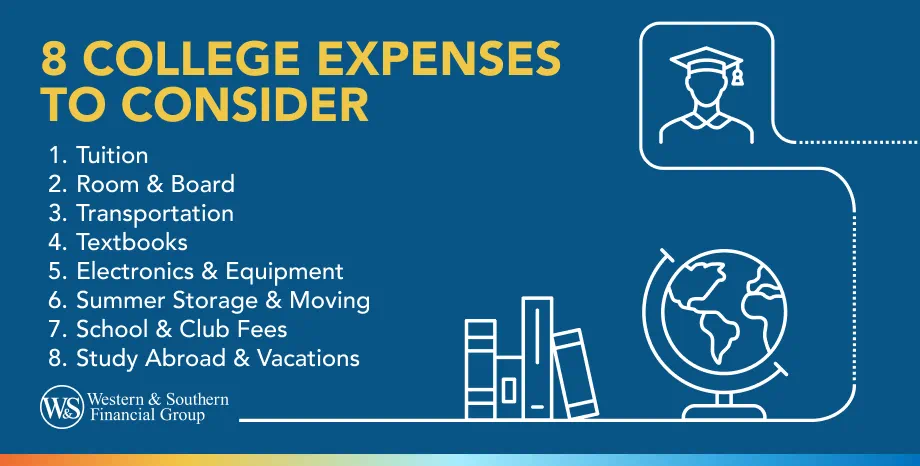

Table of Contents
Key Takeaways
- Tuition is often the largest college expense, with private universities costing an average of $43,350 annually.1
- Room and board can add an additional $10,450 to $15,040 per year, depending on the type of school.1
- Transportation costs vary, with students at public two-year schools spending about $1,960 annually on commuting.1
- Textbooks and supplies can cost students around $1,280 annually, though used books can help reduce expenses.1
- Summer storage and moving between academic years can add unexpected costs for on-campus students.
If you or a family member are hoping to attend college in the future, it can be helpful to start planning for college expenses ahead of time. This way, you can start figuring out how much you might need to save while also setting your budget. To help you prepare for the overall cost of college, here are some common expenses to consider.
1. Tuition
Tuition is often one of the largest expenses for students. For the 2024-2025 school year, it costs the average in-state student $11,610 for tuition and fees at a four-year public school, while the average cost for out-of-state students is $30,780, according to the College Board.1 Private four-year universities are even more expensive, with an average cost of $43,350 for tuition and fees. When you plan your budget, you should also consider that tuition is increasing over time, and it also may take more than four years to graduate.
2. Room & Board
The College Board estimated that 2024-2025 college room and board costs students $10,450 (at public two-year in-district schools), $13,030 (at public four-year schools), and $15,040 (at private nonprofit four-year schools). Room and board typically includes the cost of staying in a dorm or renting an apartment, utilities, and food. In addition to food and housing, there are other personal expenses to consider, such as clothing, laundry, toiletries, and entertainment. According to the College Board, students were estimated to spend an average of $2,430 (public two-year in-district commuter), $2,200 (public four-year on-campus), and $1,830 (private nonprofit four-year on-campus) on these other expenses in 2024-2025.
3. Transportation
How will you or your family member get to school? Consider the cost of flights, train or bus tickets, or gas for your vehicle, especially if you're looking at schools far from home.
For students who plan on owning a car while on-campus, this means keeping up with vehicle payments, gas, insurance, and parking at the college. Students who live close to campus could pay significantly less by walking, biking, or taking the campus bus to class.
The College Board reported average 2024-2025 transportation budgets for students to be $1,960 for commuters at public two-year in-district schools, $1,350 for on-campus students at public four-year schools, and $1,160 for those attending private nonprofit four-year schools.
4. Textbooks
You'll also need textbooks for most (if not all) of your classes. The College Board estimates that students spend more than $1,280 a year on books and supplies (such as notebooks, binders, pens, and art and laboratory materials). Students may be able to save money on these college expenses by renting or buying used textbooks when possible.
5. Electronics & Equipment
A laptop can help with studying and save some trips to the school computer lab. In addition, students might also need a printer. Dorm rooms may also need some furnishings such as lamps, a microwave, a mini fridge, sheets, towels, and furniture. This might require spending more the first year to buy necessary items, then some minor spending afterward as you replace and repair items.
6. Summer Storage & Moving
On-campus students typically have to move between school years after dorms are closed. It could cost upward of a few hundred dollars to rent a U-Haul and buy packing materials. Depending on your circumstances, you might also need to rent storage space to hold onto your belongings during the summer, which can tack on an additional cost. The College Board estimates that students spend over $1,280 annually on books and supplies like notebooks, binders, pens, and lab materials.
7. School & Club Fees
Your college of choice may charge extra fees on top of tuition to fund clubs, student centers, campus gyms, and other facilities. Students who participate in sports leagues and Greek life might also be charged membership fees.
8. Study Abroad & Vacations
While studying abroad in another country can be a nice addition to a college program, it can also be expensive — roughly $14,295 per semester, according to GoAbroad.2 However, the price can vary depending on the country. For example, programs in Asian countries tend to be significantly less expensive than those in European countries.
In addition, you'll likely want to factor any spring break or summer vacations into your savings plan, too.
Preparing for the Future
To help cover qualified expenses, you could put money aside using a 529 college savings plan. These accounts allow you to contribute money that has the potential to grow (although growth is not guaranteed and the plan could lose money instead). Not only do these plans have the potential to grow tax-deferred, but you also may not have to pay federal or state taxes when you use distributions from the plan to pay for qualifying educational expenses.
For more information on getting ready for college expenses and putting together a budget, consider speaking with a registered representative to weigh your options.
Investors should carefully consider investment objectives, risks, charges, and expenses before investing in a 529 savings plan. This and other important information is contained in the Issuers Program Description which can be obtained from a financial professional. The Program Description should be read carefully before investing.
Sources
- Trends in College Pricing and Student Aid 2024. https://research.collegeboard.org/media/pdf/Trends-in-College-Pricing-and-Student-Aid-2024-ADA.pdf.
- The Average Cost of Study Abroad Programs Around the World - A Study. https://www.goabroad.com/articles/study-abroad/average-cost-study-abroad-programs.
















